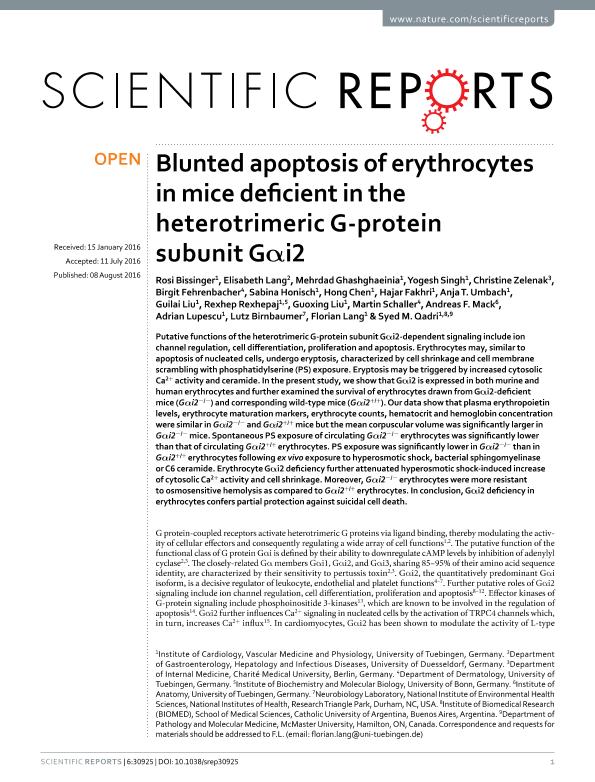Mostrar el registro sencillo del ítem
dc.contributor.author
Bissinger, Rosi
dc.contributor.author
Lang, Elisabeth
dc.contributor.author
Ghashghaeinia, Mehrdad
dc.contributor.author
Singh, Yogesh
dc.contributor.author
Zelenak, Christine
dc.contributor.author
Fehrenbacher, Birgit
dc.contributor.author
Honisch, Sabina
dc.contributor.author
Chen, Hong
dc.contributor.author
Fakhri, Hajar
dc.contributor.author
Umbach, Anja T.
dc.contributor.author
Liu, Guilai
dc.contributor.author
Rexhepaj, Rexhep
dc.contributor.author
Liu, Guoxing
dc.contributor.author
Schaller, Martin
dc.contributor.author
Mack, Andreas F.
dc.contributor.author
Lupescu, Adrian
dc.contributor.author
Birnbaumer, Lutz

dc.contributor.author
Lang, Florian
dc.contributor.author
Qadri, Syed M.
dc.date.available
2018-03-28T16:47:55Z
dc.date.issued
2016-08
dc.identifier.citation
Bissinger, Rosi; Lang, Elisabeth; Ghashghaeinia, Mehrdad; Singh, Yogesh; Zelenak, Christine; et al.; Blunted apoptosis of erythrocytes in mice deficient in the heterotrimeric G-protein subunit Gαi2; Nature Publishing Group; Scientific Reports; 6; 8-2016; 1-10; 30925
dc.identifier.issn
2045-2322
dc.identifier.uri
http://hdl.handle.net/11336/40386
dc.description.abstract
Putative functions of the heterotrimeric G-protein subunit Gαi2-dependent signaling include ion channel regulation, cell differentiation, proliferation and apoptosis. Erythrocytes may, similar to apoptosis of nucleated cells, undergo eryptosis, characterized by cell shrinkage and cell membrane scrambling with phosphatidylserine (PS) exposure. Eryptosis may be triggered by increased cytosolic Ca2+ activity and ceramide. In the present study, we show that Gαi2 is expressed in both murine and human erythrocytes and further examined the survival of erythrocytes drawn from Gαi2-deficient mice (Gαi2−/−) and corresponding wild-type mice (Gαi2+/+). Our data show that plasma erythropoietin levels, erythrocyte maturation markers, erythrocyte counts, hematocrit and hemoglobin concentration were similar in Gαi2−/− and Gαi2+/+ mice but the mean corpuscular volume was significantly larger in Gαi2−/− mice. Spontaneous PS exposure of circulating Gαi2−/− erythrocytes was significantly lower than that of circulating Gαi2+/+ erythrocytes. PS exposure was significantly lower in Gαi2−/− than in Gαi2+/+ erythrocytes following ex vivo exposure to hyperosmotic shock, bacterial sphingomyelinase or C6 ceramide. Erythrocyte Gαi2 deficiency further attenuated hyperosmotic shock-induced increase of cytosolic Ca2+ activity and cell shrinkage. Moreover, Gαi2−/− erythrocytes were more resistant to osmosensitive hemolysis as compared to Gαi2+/+ erythrocytes. In conclusion, Gαi2 deficiency in erythrocytes confers partial protection against suicidal cell death.
dc.format
application/pdf
dc.language.iso
eng
dc.publisher
Nature Publishing Group
dc.rights
info:eu-repo/semantics/openAccess
dc.rights.uri
https://creativecommons.org/licenses/by/2.5/ar/
dc.subject
Gi2alpha
dc.subject
G Protein
dc.subject
Erythocyte
dc.subject
Apoptosis
dc.subject.classification
Inmunología

dc.subject.classification
Medicina Básica

dc.subject.classification
CIENCIAS MÉDICAS Y DE LA SALUD

dc.title
Blunted apoptosis of erythrocytes in mice deficient in the heterotrimeric G-protein subunit Gαi2
dc.type
info:eu-repo/semantics/article
dc.type
info:ar-repo/semantics/artículo
dc.type
info:eu-repo/semantics/publishedVersion
dc.date.updated
2018-03-20T14:33:45Z
dc.journal.volume
6
dc.journal.pagination
1-10; 30925
dc.journal.pais
Alemania

dc.description.fil
Fil: Bissinger, Rosi. Eberhard Karls Universität Tübingen; Alemania
dc.description.fil
Fil: Lang, Elisabeth. Universitat Dusseldorf; Alemania
dc.description.fil
Fil: Ghashghaeinia, Mehrdad. Eberhard Karls Universität Tübingen; Alemania
dc.description.fil
Fil: Singh, Yogesh. Eberhard Karls Universität Tübingen; Alemania
dc.description.fil
Fil: Zelenak, Christine. Charité Medical University; Alemania
dc.description.fil
Fil: Fehrenbacher, Birgit. Eberhard Karls Universität Tübingen; Alemania
dc.description.fil
Fil: Honisch, Sabina. Eberhard Karls Universität Tübingen; Alemania
dc.description.fil
Fil: Chen, Hong. Eberhard Karls Universität Tübingen; Alemania
dc.description.fil
Fil: Fakhri, Hajar. Eberhard Karls Universität Tübingen; Alemania
dc.description.fil
Fil: Umbach, Anja T.. Eberhard Karls Universität Tübingen; Alemania
dc.description.fil
Fil: Liu, Guilai. Eberhard Karls Universität Tübingen; Alemania
dc.description.fil
Fil: Rexhepaj, Rexhep. Universitat Bonn; Alemania
dc.description.fil
Fil: Liu, Guoxing. Eberhard Karls Universität Tübingen; Alemania
dc.description.fil
Fil: Schaller, Martin. Eberhard Karls Universität Tübingen; Alemania
dc.description.fil
Fil: Mack, Andreas F.. Eberhard Karls Universität Tübingen; Alemania
dc.description.fil
Fil: Lupescu, Adrian. Eberhard Karls Universität Tübingen; Alemania
dc.description.fil
Fil: Birnbaumer, Lutz. National Institutes of Health; Estados Unidos. Consejo Nacional de Investigaciones Científicas y Técnicas. Oficina de Coordinación Administrativa Houssay; Argentina
dc.description.fil
Fil: Lang, Florian. Eberhard Karls Universität Tübingen; Alemania
dc.description.fil
Fil: Qadri, Syed M.. Eberhard Karls Universität Tübingen; Alemania. Pontificia Universidad Católica Argentina "Santa María de los Buenos Aires". Facultad de Ciencias Médicas. Instituto de Investigaciones Biomédicas; Argentina
dc.journal.title
Scientific Reports
dc.relation.alternativeid
info:eu-repo/semantics/altIdentifier/doi/http://dx.doi.org/10.1038/srep30925
dc.relation.alternativeid
info:eu-repo/semantics/altIdentifier/url/https://www.nature.com/articles/srep30925
Archivos asociados
